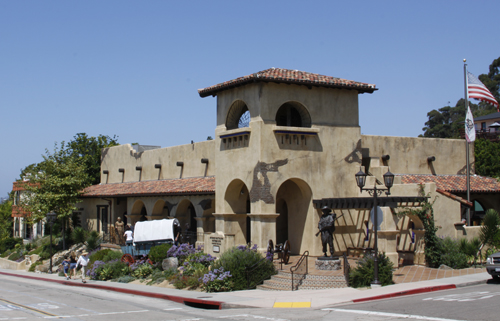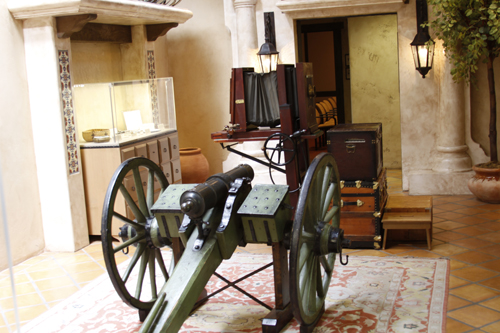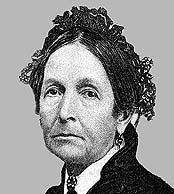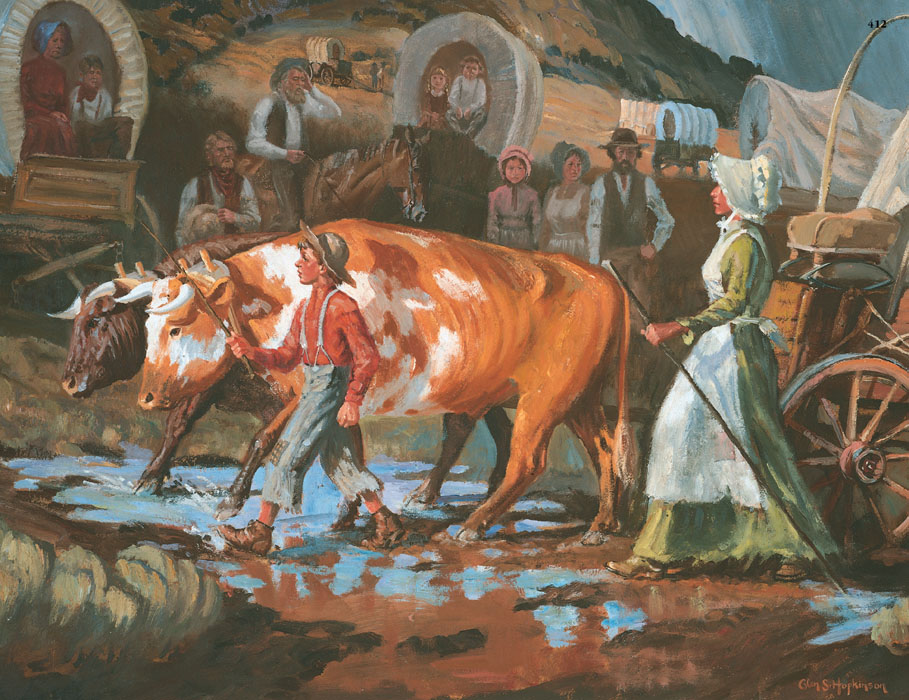Looking for something free, air conditioned, and fun to do in Old Town, San Diego? A year ago, the Mormon Battalion Visitor’s Center was renovated to make it a destination praised by Mormons (the nickname sometimes applied to members of The Church of Jesus Christ of Latter-day Saints) and non-Mormons alike. The twenty-minute tour takes visitors back into San Diego’s early history, which played a pivotal role in Mormon history as well. The religious aspects of the tour are minimal and there is no effort to convert visitors. If they want to learn more about the Mormons, they can fill out a request card or ask questions on their own. Otherwise, the focus is on the historical events.
 The visitor’s center is hosted by Mormon missionaries in period clothing. Visitors “travel” with the Mormon Battalion to explore this part of Mormon history by moving from room to room, sitting on logs, benches, or rocks during presentations to make it more real. Videos in each room are cleverly designed to provide an interactive feel to them. In the first room, you’re welcomed by missionaries and have a chance to see photographs on the wall of some of the participants in the events—men and women, and even one child. Unexpectedly, the people in the photographs begin to talk, Disneyland-style. The tour guide invites one of them, a teenager who talked his way into the Battalion despite being underage—to tell his story. In another, a window is suddenly revealed to be a video screen as one of the actors knocks on the window and proceeds to tell you more about his story. In a pioneer shop, guests are shown what each soldier was given in the way of supplies and one is dressed in the outfit. Everyone is invited to hold the musket, which is startlingly heavy. Missionaries chat with the actors on-screen to provide an entertaining historical lesson.
The visitor’s center is hosted by Mormon missionaries in period clothing. Visitors “travel” with the Mormon Battalion to explore this part of Mormon history by moving from room to room, sitting on logs, benches, or rocks during presentations to make it more real. Videos in each room are cleverly designed to provide an interactive feel to them. In the first room, you’re welcomed by missionaries and have a chance to see photographs on the wall of some of the participants in the events—men and women, and even one child. Unexpectedly, the people in the photographs begin to talk, Disneyland-style. The tour guide invites one of them, a teenager who talked his way into the Battalion despite being underage—to tell his story. In another, a window is suddenly revealed to be a video screen as one of the actors knocks on the window and proceeds to tell you more about his story. In a pioneer shop, guests are shown what each soldier was given in the way of supplies and one is dressed in the outfit. Everyone is invited to hold the musket, which is startlingly heavy. Missionaries chat with the actors on-screen to provide an entertaining historical lesson.
At the end of the formal tour, visitors may view a variety of artifacts and displays and may have their photo taken in a Battalion setting (without costumes.) Each visitor receives a printed photo and the option of having it emailed to them as well. An outdoor area is very child-friendly and hands-on. Children—and even adults—may pan for fool’s gold. There are stick horses, costumes, and other activities for the children to try out. A trip upstairs gives you a lovely view of Old Town and the displays point out the other historic sites in the area. This is a fun way to learn Mormon history without pressure, textbooks, or tests.
The Mormon Battalion is a unique segment of Mormon history. It was formed while the Mormons were on their way to Utah. Prior to the trek west, they had learned that freedom of religion had serious limitations and that the Constitution, at that time, did not allow the federal government to prevent states from ignoring the Constitution’s laws. This would be remedied after the Civil War, too late to help these early Mormons. As a result, there were no real consequences for mobs that attacked, robbed, tortured, and even killed Mormon men, women, and children. In Missouri, the governor issued an extermination order on the Mormons who lived in his state. With this passage, mobs were free to do whatever they wanted to do to the Mormons, and their leader, Joseph Smith, was murdered, as were other Mormons. The Mormons were forced out of several states in these early years, including Missouri, Ohio, and Illinois.
With all this sad Mormon history behind them, and with many having been forced to give up their homes and possessions and even their families again and again with no support from a president who had made it clear it wasn’t in his best political interest to intervene, it was naturally upsetting to many Mormons when a delegation from the United States Army arrived at one of the Mormon pioneer camps. He approached the camp leader and said the president wanted Mormons to enlist in the war against the Mexicans.
Most felt the government was out of line running to them for help when their own pleas for help had gone unanswered. They also wondered how their wives and children would manage the long trek and the initial work of settling a new land without them. However, a message was sent by the camp leader to Brigham Young who arrived at that camp with the military leaders. He helped his people to understand the money the soldiers would be paid would help their families purchase desperately needed food and supplies. It would also show the government the Mormons were good Americans, even if they had been forced out of the country by that same government. (They were currently in Iowa, which was not yet a part of the United States.) He prophesied that they would face no fighting and promised to have their families watched over. With Brigham Young’s encouragement, 541 soldiers enlisted. In addition 35 women accompanied them, most as laundresses. These women brought with them 42 children. The company also included one nine-year-old boy, Charles Colton, who slipped away from camp because he wanted to serve with his father. Because no one was available to return him, he was allowed to stay.
The Mormon Battalion marched 2000 miles to San Diego, one of the longest military treks in history. During the journey they built roads others would be able to use in the future. The rations provided them were insufficient and they were often extremely hungry and thirsty. They had chosen to send the money from their clothing allowance back to their families, so they were insufficiently clothed, as well. Since the women and children had no rations, they had to be cared for from the meager rations the men were given, further depleting their supplies.
 Brigham Young’s prophecy came to pass. The only shooting done on this journey was to defend themselves against a cattle stampede, in what humorously became known as the Battle of the Bulls. However, twenty men died from poor nutrition, sanitation conditions, and thirst. There was an enormous amount of suffering. They were forced to march with a regular army group led by the same man who had forced them out of Missouri and this man, Colonel Price, refused to share rations until forced to do so. (The regular Army was better provisioned.) They were assigned a doctor who believed calomel and arsenic were the cure for everything, and these he served on one rusty spoon to be shared by all. Since these “cures” were poisonous, the dosage was quite dangerous to those forced to take it.
Brigham Young’s prophecy came to pass. The only shooting done on this journey was to defend themselves against a cattle stampede, in what humorously became known as the Battle of the Bulls. However, twenty men died from poor nutrition, sanitation conditions, and thirst. There was an enormous amount of suffering. They were forced to march with a regular army group led by the same man who had forced them out of Missouri and this man, Colonel Price, refused to share rations until forced to do so. (The regular Army was better provisioned.) They were assigned a doctor who believed calomel and arsenic were the cure for everything, and these he served on one rusty spoon to be shared by all. Since these “cures” were poisonous, the dosage was quite dangerous to those forced to take it.
Only 339 people made it all the way to San Diego. The longest trek in military history—and one of the longest in Mormon history—ended in California, many arriving barefoot because their shoes had long since worn out.
Although they had been sent to fight the Mexicans, once they arrived, they, in typical Mormon fashion, settled in for a while to help the Mexicans build their city. They helped build the first courthouse, some of the roads, and other buildings in what is now Old Town. Little Charles Colton’s father and three other men made 40,000 bricks that were used in the building process. Officially, they were occupation troops, but they established a good relationship with the local people.
When their one-year enlistment ended, eighty-one men re-enlisted. Most of the remainder headed for San Francisco, intending from there to head for Salt Lake City, Utah. However, a church leader delivered a message from Brigham Young asking those who did not have families in Utah to stay and work. The income was much needed. Many did so and so some were participants in the discovery of gold at Sutter’s Mill. Other men observed the irrigation process used by immigrants, a skill they took home to use in the famous irrigation of Utah, bringing water to the desert.
While the formation of the Mormon Battalion brought hardships to both the men and their families, Brigham Young was inspired in his decision to encourage the men to put aside their anger and hurt at the way their government had treated them. The trek allowed them to earn much needed income to assist Mormons in making the journey to Utah, taught them valuable skills, and sent a clear (although often ignored) message that Mormons were loyal Americans despite their rejection by their nation. It was a critical time in Mormon history, one that impacted both the nation and the small group of religious pilgrims headed for a promised land in Utah.
The Mormon Battalion Monument is located at 2510 Juan Street in San Diego, California, in the Old Town historic district. It is open from 9 AM to 9 PM, seven days a week, and is entirely free. (There is not even a charge for the photo and there is no gift shop or other means of spending money.)
About Terrie Lynn Bittner
The late Terrie Lynn Bittner—beloved wife, mother, grandmother, and friend—was the author of two homeschooling books and numerous articles, including several that appeared in Latter-day Saint magazines. She became a member of the Church at the age of 17 and began sharing her faith online in 1992.





